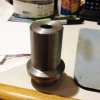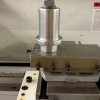Gary
SE Kansas
I have started a project of turning an adapter that will fit over the QCTP mounting bolt. Fairly straight forward and should be easy enough to make even with my limited skills. Here's a problem I encountered: I need to drill a center hole of approx. .550" and whatever the steel happens to be, it's super hard to drill. The round I'm using used to be a wrist pin on a JD tractor/excavator. It's 2" x 3". It cuts fairly easily on the lathe but drilling is a total other thing. I started by center drilling and followed with a 1/4" drill bit. No go, and this drill bit is new. Any suggestions?





